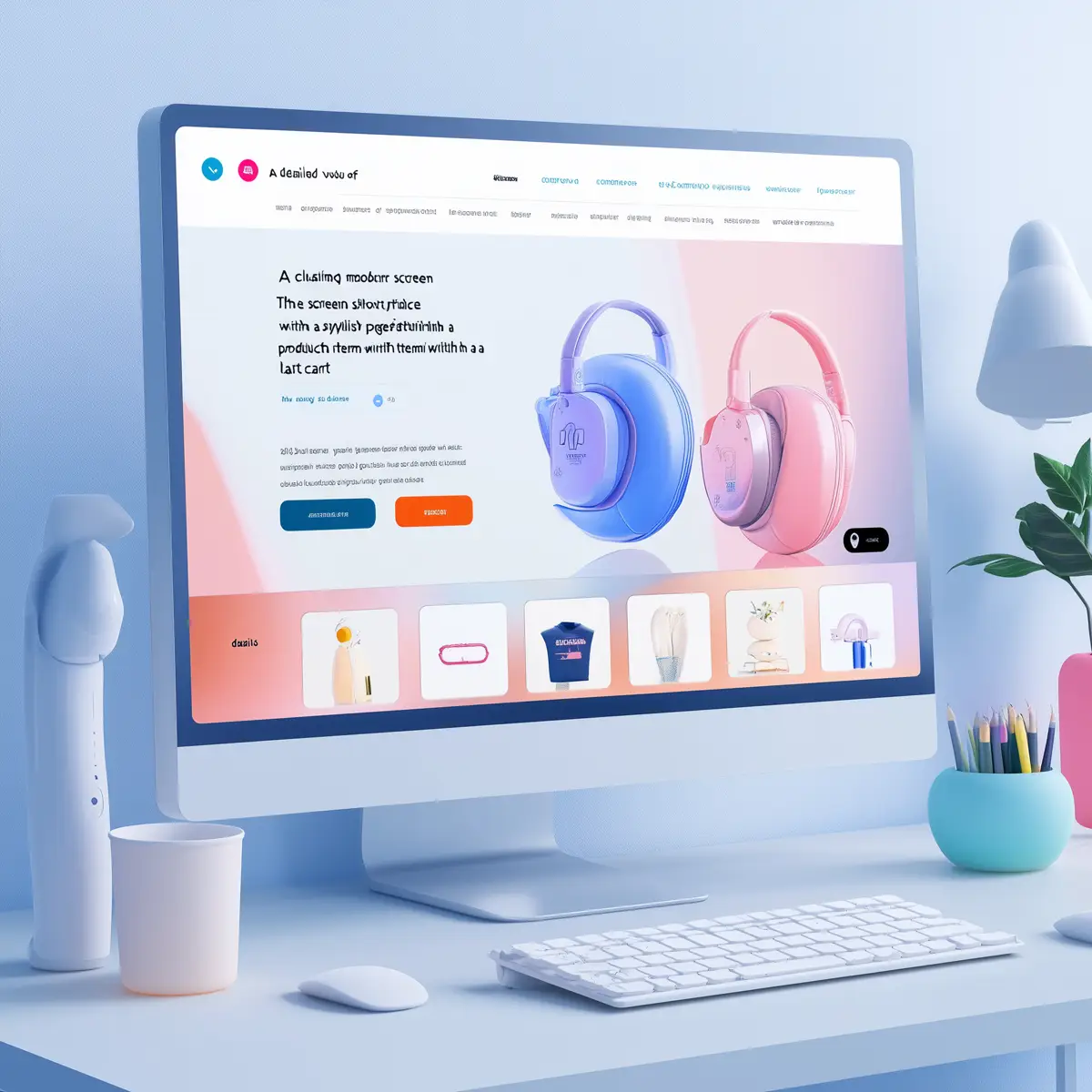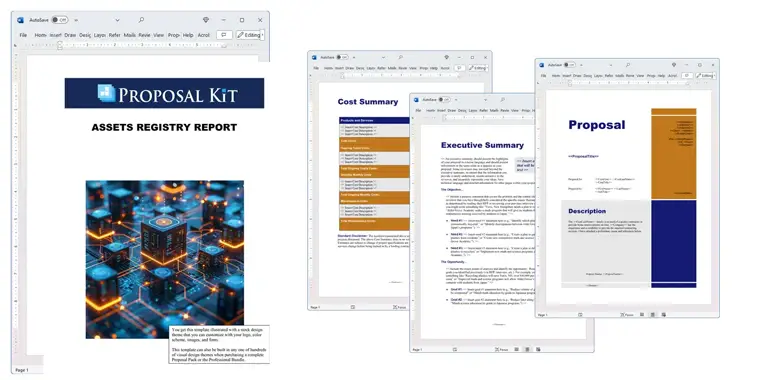How to write your Assets Registry Report
We include this 10 page layout with every Proposal Pack. If you want this template to have a different visual design theme than the one illustrated here, purchase any Proposal Pack design and create this template using the purchased design theme. This template is included in every Proposal Pack. If you get a Proposal Pack or the Professional Bundle, you can also make any variation of this template with different chapters to suit your needs.
We typically include more chapters in the templates than most people will need to give everyone more variety in the chapters they may need. You can trim down a long template by removing pages you do not need or combining multiple chapter topics into one page.
 DOWNLOADABLE, ONE-TIME COST, NO SUBSCRIPTION FEES
DOWNLOADABLE, ONE-TIME COST, NO SUBSCRIPTION FEES If you need this template on DVD media order from our Amazon shop.
If you need this template on DVD media order from our Amazon shop.
You can also create countless variations of this document to suit your needs using the included library of 2200+ chapters if ordering a Proposal Pack or Pro Bundle.
 What Our Clients Say
What Our Clients SayI’m in the health industry, I had no idea how to write a proposal and couldn’t find any examples or help on the topic so after reading reviews I decided to purchase this product. It’s a pretty simple format easy to understand with many useful examples that I used to contrast with, which for me was the greatest value allowing me to better understand how proposals are formatted and written and since this product is fairly inexpensive I would highly recommend it."
Related Article
Related Video
Related Templates
- Sale of Business and Assets Proposal
- Selling a Web Site and Digital Assets Proposal
- Asset Management Services Proposal
- Asset Tracking and Management Project Proposal
- Bankruptcy and Foreclosure Crisis Report
- Accounting Services Proposal Template
- Annual Report
- Reserve Study
What's the Best Way to Write Your Assets Registry Report?
A proven solution for creating a comprehensive assets registry report is the Proposal Kit template library and Wizard software program. This robust system offers tailored templates and features a line item quoting database system. This system is invaluable for handling cost summaries, quotes, estimates, budgets, and other financial details critical to your report.
If you need to create such a detailed and financially integrated report, the Proposal Kit is a proven tool. A proposal kit is made for writing reports and proposals.
What Types of Projects Are Assets Registry Reports Written For?
Assets registry reports are documents used across various projects where detailed asset tracking and management are crucial. Here are some situations where such reports are essential:
- Corporate asset audits
- Equipment tracking for manufacturing firms
- Property management for real estate companies
- Technology asset management in IT companies
- Inventory reports for retail businesses
- Financial asset reporting for banks
- Insurance documentation for risk assessment
- Estate management for legal firms
- Facility management for hospitals
- Asset verification for mergers and acquisitions
- Compliance reporting for governmental organizations
- Grant reporting for non-profits
- Resource allocation in educational institutions
- Maintenance scheduling for transportation companies
- Quality control for production lines
- Project planning for construction companies
- Asset lifecycle analysis for consultancy firms
- Sustainability reporting for environmental agencies
- Security planning for security firms
- Disaster recovery planning for emergency services
Chapters this template is built with
No single template can meet all the diverse needs of an assets registry report, which is why the Proposal Kit software is designed to help you customize your document precisely.
Each chapter can be fully customized using the templates provided in a Word format. After editing, save your document as a PDF for easy sharing and professionalism.
Here's a glimpse at how you can use various chapter templates from Proposal Kit's extensive library to address different aspects of your report:
Asset Management
Use this chapter to outline how assets are currently managed and potential improvements. Specifically, you can detail the current tracking, maintaining, and updating asset information processes. This chapter can include protocols for periodic audits, software tools used for asset management, and any automated systems in place. For example, describe how your organization uses RFID tags to keep real-time track of physical assets or the specific software employed to manage digital assets.
Diversification
This chapter discusses the importance of asset diversification and strategies to minimize risks. Specifically, highlight different categories of assets such as real estate, equipment, intellectual property, and financial investments. The chapter can assess each category's risk and suggest diversification strategies, such as investing in different geographic regions or sectors. For instance, if your company primarily invests in technology, consider diversifying into healthcare or renewable energy sectors to spread risk.
Assets
Detail the actual assets under management, including their conditions and values. This chapter should provide a comprehensive list of all assets, categorized by type and including specifics such as serial numbers, purchase dates, depreciation schedules, and current market values. Visual aids like tables or charts can help illustrate the distribution and condition of assets. For example, a table might list office equipment with columns for purchase date, initial cost, current value, and condition (new, good, fair, poor).
Capital Assets
Focus on the critical high-value assets that influence the organization's financial health. This chapter should spotlight assets significantly impacting the company's balance sheet, such as buildings, machinery, and significant technological infrastructure. Detailed financial metrics, such as return on investment (ROI) and total cost of ownership (TCO), can be included to provide a comprehensive view. For example, include a case study of a capital asset like a new manufacturing plant, detailing its purchase cost, operational expenses, and the revenue it generates.
Return on Assets
Analyze and report on how the organization's assets are being used to generate earnings. This chapter can include metrics like Return on Assets (ROA) and Asset Turnover Ratio. You can also compare these metrics against industry benchmarks to provide context. For instance, a chart comparing your company's ROA to the industry average can highlight areas for improvement or confirm effective asset utilization strategies.
Reporting
Provide a framework for conducting asset reporting, ensuring clarity and compliance. This chapter should outline the frequency and methodology of asset reporting, including who is responsible for compiling and verifying the data. It can also describe the software and tools used for reporting and any compliance requirements that must be met. For example, explain how monthly asset reports are generated using a specific asset management software and reviewed by the finance department for accuracy and compliance with GAAP (Generally Accepted Accounting Principles).
Recommendations
Conclude your report with recommendations for future asset management improvements. This chapter should provide actionable insights based on the data and analysis presented in the previous sections. Recommendations can include adopting new technologies, streamlining processes, or identifying areas for additional investment. For example, consider implementing an AI-based asset tracking system to improve accuracy and reduce manual labor.
Use cases for this template
Streamlining Asset Management
John, owner of a tech start-up named Global Tech Innovations, faced a challenging task. He needed to create a comprehensive assets registry report to attract potential investors. John knew the importance of effectively detailing his asset management strategy, but he needed to gain the experience and tools to compile such a sophisticated document.
John turned to Proposal Kit and was pleasantly surprised by its user-friendly interface and extensive library of templates. He used the dedicated asset management templates to outline the current state of his company's assets, including high-value tech equipment and software licenses necessary to his business. The line item quoting database system allowed him to accurately summarize costs, estimates, and essential budgets.
Notably, John customized the report's recommendations section to highlight future asset acquisitions and management improvements, clearly showing his vision. John secured the investment funds to drive his start-up forward by presenting a professionally formatted and detailed assets registry report.
Quick Turnaround Projects
Emily worked for Dynamic Designs, a growing design firm that frequently handled high-stakes projects. She was tasked with writing an assets registry report for an important client, but the deadline was looming. The pressure was immense, and she needed a solution that could help her meet the deadline without compromising on quality.
Emily turned to Proposal Kit and leveraged an AI writing tool for assistance. She used Proposal Kit's customizable templates to create a comprehensive report framework. With the AI tool, she prompted it to analyze Dynamic Designs' website and other related content, generating relevant and accurate text for specific chapters of the report.
She detailed the assets her company managed for the client, including design software, creative tools, and valuable intellectual property. The AI tool helped generate insightful content for the recommendations section, suggesting innovative ways to enhance the client's asset utilization.
Emily met her tight deadline thanks to the Proposal Kit and the AI writing tool. She delivered a polished and professional assets registry report, impressing her client and reinforcing Dynamic Designs' reputation for excellence and reliability.
Non-Profit Organizational Planning
David, the director at Helping Hands Network, a non-profit organization dedicated to community support, faced the challenge of writing a Request for Proposal (RFP) for asset management services. The organization needed a detailed and compelling document to attract proficient service providers who could manage their diverse assets, from real estate to donated goods.
David realized that creating such a specialized report required professional-grade tools, so he turned to Proposal Kit. He outlined the organization's asset management needs, goals, and expectations using the RFP templates. The templates allowed him to incorporate detailed descriptions of the assets, current management practices, and areas needing improvement.
David also used the reporting and recommendations sections to provide a clear framework for potential service providers, ensuring they understood the project's scope and importance. With the Proposal Kit, he was able to write a comprehensive and compelling RFP that was both informative and professionally formatted.
As a result, Helping Hands Network received numerous high-quality proposals from reputable asset management firms, enabling them to make an informed decision and significantly improve their asset management practices.
Conclusions and Recommendations
Using Proposal Kit templates and software significantly eases the challenge of writing detailed asset registry reports. From managing complex financial data to meeting urgent deadlines with AI tools, Proposal Kit provides all the tools to ensure your report is professional and comprehensive. Proposal Kit helps you create tailored documents that meet specific project needs, enhancing your ability to manage assets effectively.
Also Known As
This template may also be referred to in different ways or be used in more specialized situations, such as:
- Asset Inventory Report
- Asset Management Overview
- Asset Tracking Document
- Property Registry Log
- Equipment Registry File
- Capital Asset Analysis
- Asset Allocation Summary
- Investment Property Report
- Facility Asset Register
- Technology Asset Review
Abstract
 An assets registry report is essential for businesses to keep track of all their valuable assets, including fixed assets, intangible assets, and tangible assets. Maintaining an accurate asset register enables companies to efficiently allocate resources and ensure efficient resource allocation. By using an asset management system or asset register software, businesses can collect and maintain all their asset data in one place, enhancing data integrity and operational efficiency.
An assets registry report is essential for businesses to keep track of all their valuable assets, including fixed assets, intangible assets, and tangible assets. Maintaining an accurate asset register enables companies to efficiently allocate resources and ensure efficient resource allocation. By using an asset management system or asset register software, businesses can collect and maintain all their asset data in one place, enhancing data integrity and operational efficiency.
Tracking assets across multiple locations can be challenging, especially for larger companies with various asset types like company vehicles, office furniture, and computers. Implementing asset tracking software helps in keeping track of asset location, asset usage, and asset status. Regularly updating the fixed asset register and conducting periodic reviews or physical audits can prevent discrepancies and missing assets, ensuring the company's losses are minimized.
Creating an asset register involves collecting detailed information related to each asset, such as asset name, serial number, acquisition cost, estimated value, and remaining life. Including maintenance records and depreciation calculations provides valuable insights into asset performance and helps in budgeting and planning for repairs or replacements. Understanding the depreciation method and depreciation status of each asset is vital for accurate financial reporting and tax compliance.
 By integrating the asset register with other business systems like accounting software, companies can reflect the accurate asset value and asset depreciation in their financial statements. This integration supports revenue generation by optimizing cash flow and enables businesses to make informed decisions based on up-to-date data. Maintaining an accurate asset register also assists in legal issues and regulatory compliance, as it provides a comprehensive record that can be verified by tax authorities.
By integrating the asset register with other business systems like accounting software, companies can reflect the accurate asset value and asset depreciation in their financial statements. This integration supports revenue generation by optimizing cash flow and enables businesses to make informed decisions based on up-to-date data. Maintaining an accurate asset register also assists in legal issues and regulatory compliance, as it provides a comprehensive record that can be verified by tax authorities.
For smaller businesses, a simple spreadsheet like Microsoft Excel may suffice to create an asset register. However, as businesses grow, investing in a more sophisticated asset register system becomes beneficial. This system can automate data entry, maintain dynamic information, and generate custom reports that provide valuable insights into asset trends and performance. It also helps in defining responsibilities among team members and departments, promoting accountability and efficient operations.
Regularly reviewing and updating asset information is crucial to maintain data accuracy. This includes updating the asset location, asset maintenance schedules, and any changes in asset value or asset usage. By doing so, businesses can quickly identify specific assets, optimize resource allocation, and plan for future asset acquisition or disposal. Keeping track of the useful life and repair costs of assets like hardware and equipment enables businesses to operate smoothly without unexpected downtime.
 In conclusion, maintaining an accurate and up-to-date asset register is vital for businesses of all sizes. It not only helps in keeping track of all the information related to assets but also supports efficient resource allocation, financial reporting, and regulatory compliance. By implementing effective asset management practices, businesses can save time, reduce effort, and enhance overall performance.
In conclusion, maintaining an accurate and up-to-date asset register is vital for businesses of all sizes. It not only helps in keeping track of all the information related to assets but also supports efficient resource allocation, financial reporting, and regulatory compliance. By implementing effective asset management practices, businesses can save time, reduce effort, and enhance overall performance.
Frequently Asked Questions
What is the primary purpose of an assets registry report?
The primary purpose of an assets registry report is to provide a comprehensive and organized record of all assets owned by an organization. This report helps track each asset's condition, value, and management status. It is an essential tool for financial planning, risk management, and compliance with regulatory requirements. Businesses can make informed decisions about asset utilization, maintenance, and divestment strategies using a detailed assets registry report.
How detailed should an assets registry report be?
An assets registry report should be as detailed as necessary to provide a clear and accurate picture of all assets. This includes information such as the asset's description, location, acquisition date, value, condition, and any relevant remarks about its usage or maintenance. The level of detail will depend on the organization's specific needs and the report's purpose. Proposal Kit's templates ensure that all critical details are included, making the report comprehensive and valuable for various stakeholders.
How often should an assets registry report be updated?
The frequency of updating an asset registry report largely depends on the nature of the assets and the organization's requirements. Generally, updating the report annually or whenever significant changes occur, such as the acquisition or disposal of assets, changes in asset values, or considerable maintenance activities, is recommended. Regular updates ensure the report remains accurate and reliable for decision-making and compliance purposes. Proposal Kit's software can facilitate easy updates and modifications to keep the report current.
What are the common challenges in creating an assets registry report?
One of the common challenges in creating an assets registry report is ensuring the accuracy and completeness of the data. Gathering information about all assets, verifying their condition, and determining their current value can be time-consuming and complex. Additionally, organizing the data in a clear and structured format can be challenging. Proposal Kit's templates and software tools are designed to address these challenges by providing a structured framework and database system that streamline the data collection and reporting process.
How can Proposal Kit help write an assets registry report?
Proposal Kit can significantly simplify writing an assets registry report by offering customizable templates catering to different industries and needs. The software provides a database system for managing financial details, quotes, and estimates integral to an assets registry report. With Proposal Kit, users can easily organize and present their data professionally, ensuring the report is thorough and meets all requirements. Additionally, the templates can be tailored to include specific information relevant to the organization's assets, making the final report highly pertinent and actionable.
15% Off Discount
![]() Add To Cart This Word Template Only
Add To Cart This Word Template Only
 Add To Cart Proposal Pack for Any Business
Add To Cart Proposal Pack for Any Business
 Add To Cart Proposal Kit Professional Bundle
Add To Cart Proposal Kit Professional Bundle
 4.7 stars, based on 846 reviews
4.7 stars, based on 846 reviewsProposal Kit chapters used in this template
Title Page, Table of Contents, Asset Management, Diversification, Assets, Capital Assets, Return on Assets, Reporting, Recommendations, Back Page
Included Calculator Spreadheets
These Excel calculator spreadsheets are included with this template. If you purchase a Proposal Pack or the Professional Bundle, these proposal pages are generated using an automated line-item database in the included Wizard software. The calculator spreadsheets are intended for use when purchasing only the static Word template.
You use this proposal for
- Business document, study, plan, report
- Financial, investment, legal proposal
How to create this template with Proposal Pack Wizard
You can create this document using any of the logo-designed Proposal Packs. Pick any Proposal Pack with a logo design theme you like best; they will all work equally well. The Proposal Pack for Any Business is the pack with no extra added logos or colors - designed to be used plain or for you to customize with your logos and graphics.
The Proposal Pack design theme you purchase will determine the visual look of this template. The screenshot above only shows the plain generic design theme. Names and stories in examples are fictional; however, the templates are from real client use cases.
We include a library of chapters to be assembled based on your needs. All proposals are different and have different needs and goals. We designed Proposal Pack so you can customize the documents to suit your needs.
You will best create this document using the Proposal Pack Wizard - Expert Edition software to select this template and build it in the Proposal Pack logo design theme of your choice along with any desired customizations (such as adding additional chapters, removing unneeded chapters, changing the order of chapters, and importing your company logo). This template outlines a proposal for the described situation. Each user is responsible for typing in the actual content of the provided pages with their information to complete the proposal. Suggestions in the abstract may include features in higher-end packages and are facilitated by the selection of chapter templates to support the narrative of each proposal, which help guide the user in filling in the details.
You create this template using the Wizard software with an entire Proposal Pack library and software. We include the Expert Edition of the software in the Proposal Kit Professional bundle. Microsoft Word for Windows is required to use the customizing software. You can also edit Word document templates in other office software such as Word for Mac. We will assist Mac users in assembling complex templates for their first project if they do not have the required platform to run the Wizard software.
You only get the single assembled Word document if purchased as a stand-alone template. The individual template products include no other templates, samples, or software.
How to Build Templates Featured on Proposal Kit Website
Many people find the Proposal Kit website after searching for a specific proposal. Once you've purchased and installed the software, how do you build that template you found in the first place? This video shows you how to build any proposal you see on the Proposal Kit website.
Key Takeaways
- The Assets Registry Report is available as a ready-to-edit template.
- You can create unlimited custom variations of this template using a Proposal Pack or the Professional Bundle.
- Using a Proposal Pack or Professional Bundle, you can automate quotes and other financial pages with a line-item database.
- There are no ongoing subscription fees. You get lifetime unlimited use.
- We made Proposal Kit for freelancers, small businesses, and non-profits.
- Proposal Kit product content (templates, samples, software) is 100% written by humans.
 Ian Lauder has been helping businesses write their proposals and contracts for two decades. Ian is the owner and founder of Proposal Kit, one of the original sources of business proposal and contract software products started in 1997.
Ian Lauder has been helping businesses write their proposals and contracts for two decades. Ian is the owner and founder of Proposal Kit, one of the original sources of business proposal and contract software products started in 1997.By Ian Lauder
 Published by Proposal Kit, Inc.
Published by Proposal Kit, Inc.


 Cart
Cart


 Get 15% off ordering today:
Get 15% off ordering today: 

 Facebook
Facebook YouTube
YouTube X
X Search Site
Search Site